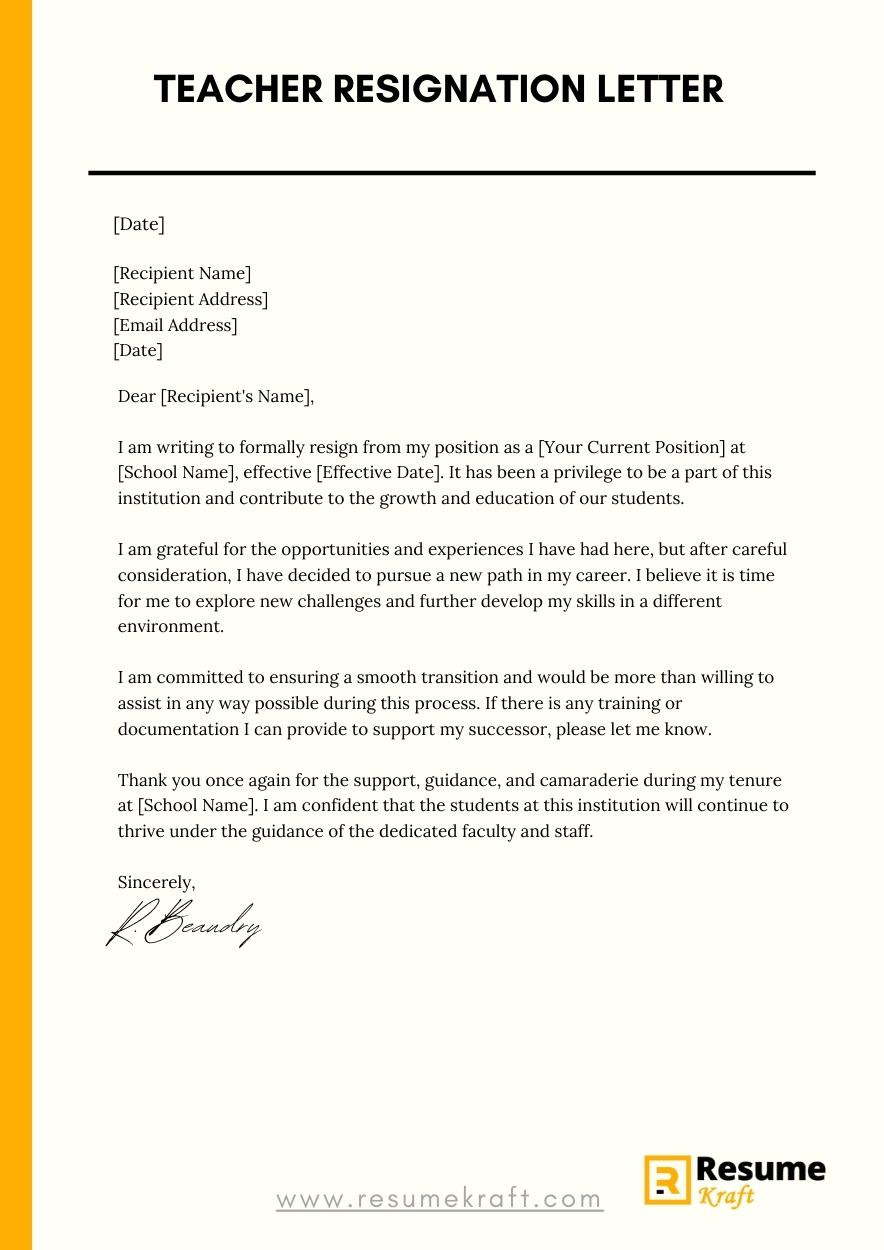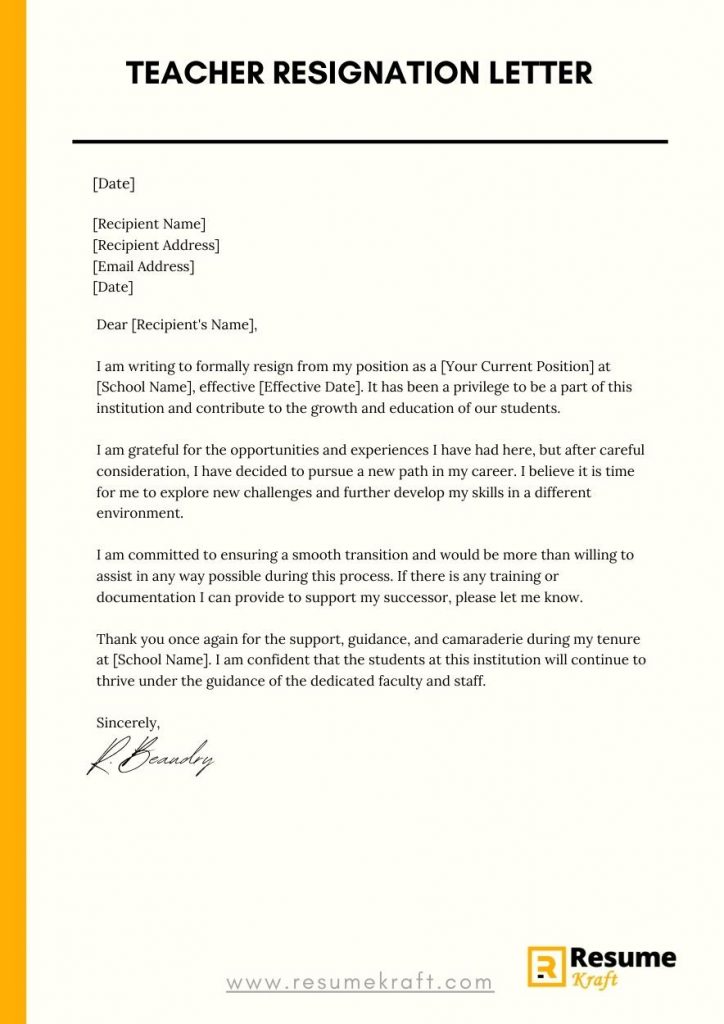
Resigning from a teaching position can be a challenging and emotional decision. Whether you have found a new opportunity, need to relocate, or simply want a change, it is important to leave your current position in a professional and respectful manner. One of the key components of this process is writing a resignation letter. In this article, we will guide you on what to include in a resignation letter, what to avoid, and how to format it properly. Additionally, we will provide you with some resignation letter samples to help you get started.
What To Include in a Resignation Letter
- Heading – Include your contact information, the date, and the recipient’s details. This sets the professional tone of the letter.
- Greeting – Address the recipient formally, using their proper title and full name.
- Statement of Intent – Begin the body of your letter by clearly stating your intention to resign from your position.
- Effective Date – Specify the date when your resignation will take effect. This will give your employer time to find a replacement.
- Reason (optional) – While not mandatory, you may choose to briefly mention your reason for resigning. Keep it concise and professional.
- Gratitude – Express your gratitude for the opportunities and experiences you have had in the teaching position. This shows appreciation and leaves a positive impression.
- Offer of Assistance – Offer to assist with the transition process, such as training your replacement or providing any necessary documentation. This gesture demonstrates professionalism and willingness to help.
- Closing – End the letter with a polite closing, such as “Sincerely” or “Best regards,” followed by your full name and signature.
What Not to Include in Your Letter
- Negative Remarks – Avoid including any negative or derogatory comments about your employer, colleagues, or the institution in your resignation letter. Maintain a positive and professional tone.
- Detailed Explanations – Keep your resignation letter concise and to the point. Avoid delving into excessive detail or overly personal information.
- Apologies – There is no need to apologize for resigning. It is a personal and professional decision, and you should not feel guilty about it.
- Future Plans (unless necessary) – Unless your resignation is directly related to a new opportunity or important career change, it is not necessary to mention your future plans in the letter.
How To Format a Resignation Letter
- Use a Professional Tone – Keep the language in your resignation letter formal and respectful. It is a professional document and should reflect that.
- Keep it Concise – Stick to the key points and avoid unnecessary details. A resignation letter should be no more than one or two pages.
- Proofread and Edit – Check for any grammatical errors or typos before finalizing your letter. It should be well-written and free of mistakes.
Resignation Letter Samples
Here are two examples of resignation letters: one in a printed format and the other in an email format.

Printed Resignation Letter Sample:
[Your Name]
[Your Address]
[City, State, ZIP]
[Email Address]
[Phone Number]
[Date]
[Recipient’s Name]
[Recipient’s Position]
[School Name]
[School Address]
[City, State, ZIP]
Dear [Recipient’s Name],
I am writing to formally resign from my position as a [Your Current Position] at [School Name], effective [Effective Date]. It has been a privilege to be a part of this institution and contribute to the growth and education of our students.
I am grateful for the opportunities and experiences I have had here, but after careful consideration, I have decided to pursue a new path in my career. I believe it is time for me to explore new challenges and further develop my skills in a different environment.
I am committed to ensuring a smooth transition and would be more than willing to assist in any way possible during this process. If there is any training or documentation I can provide to support my successor, please let me know.
Thank you once again for the support, guidance, and camaraderie during my tenure at [School Name]. I am confident that the students at this institution will continue to thrive under the guidance of the dedicated faculty and staff.
Sincerely,
[Your Full Name]
Email Resignation Letter Example:
Subject: Resignation – [Your Name]
Dear [Recipient’s Name],
I hope this email finds you well. I am writing to inform you of my decision to resign from my position as a [Your Current Position] at [School Name], effective [Effective Date].
I want to express my sincere gratitude for the opportunities I have been given and the experiences I have had during my time at [School Name]. It has been a pleasure working with the dedicated faculty, staff, and students.
As I move forward in my career, I am excited about the new opportunities that lie ahead. I understand the importance of a smooth transition and would be happy to assist in any way possible. Please let me know if there are any tasks or documentation I can provide to support the incoming [Your Position].
Thank you for your understanding and support. I am confident that [School Name] will continue to be a place of inspiration and learning for all.
Best regards,
[Your Full Name]
[Your Contact Information]
Conclusion
Writing a resignation letter is an essential step in leaving a teaching position with grace and professionalism. By following the guidelines outlined in this article, you can create a well-crafted letter that expresses your gratitude, leaves a positive impression, and ensures a smooth transition for your employer. Use the provided samples as a starting point, but don’t forget to personalize it to match your own situation. Good luck on your future endeavors!

